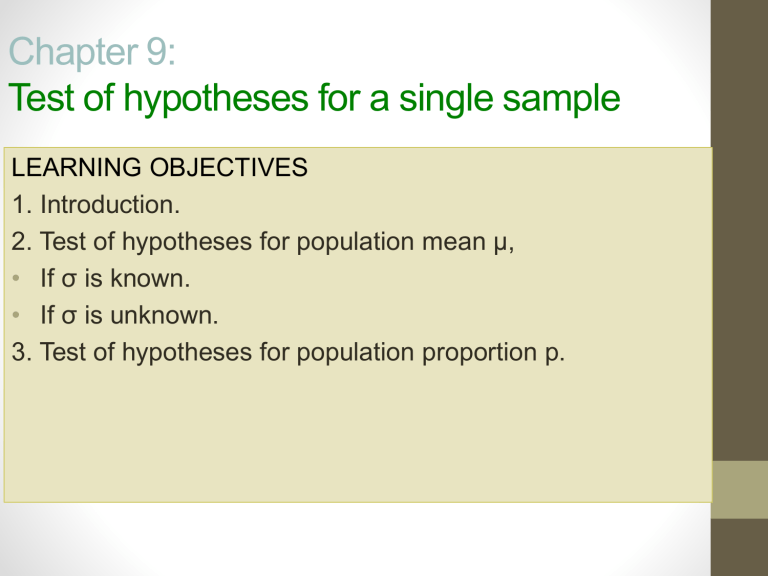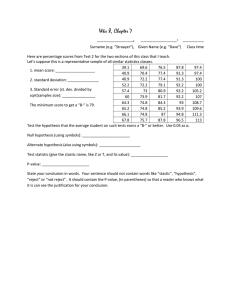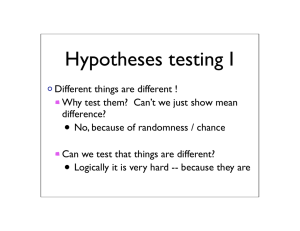
Chapter 9: Test of hypotheses for a single sample LEARNING OBJECTIVES 1. Introduction. 2. Test of hypotheses for population mean μ, • If σ is known. • If σ is unknown. 3. Test of hypotheses for population proportion p. Introduction Random Sample A company claims that the average weight of all product is 150g. Sample Mean 𝒙 = 130g Is there sufficient evident to support the claim that the true mean is 150g? Introduction Definition A statistical hypothesis is a statement about the parameters of one or more populations. Example: 1. A company claims that the mean weight all product is 150g. This is a claim about the population mean: μ = 150g. 2. A university claims that the employment rate of its students after graduation is more than 94%. This is claim about the population proportion: p > 0.94. Remark: We will use information from a random sample to make a decision whether the claim is acceptable Introduction • A procedure leading to a decision about a particular hypothesis is called a test of a hypothesis. • A (two-tailed) hypothesis test about the population mean can be formed as: H0 : 𝜇 = 𝜇0 vs H1 : 𝜇 ≠ 𝜇0 . • We call: H0: Null hypothesis H1: Alternative hypothesis Introduction Example: We wish to test: H0: 𝜇 = 150 H1: 𝜇 ≠ 150 Assume that H0: 𝜇 = 150 is true, a random sample of n = 10 objects is selected and the sample mean x is observed. • If x falls close to the hypothesized value of 𝜇 = 150, we fail to reject H0 ; it is evidence in support of the null hypothesis. • If x is considerably different from 150, we reject H0 ; it is evidence in support of the alternative hypothesis. Types of error α = P(type I error ) = P(reject H0 when H0 is true ) β = P(type II error) = P(fail to reject H0 when H0 is false) Test of hypotheses for population mean μ (σ is known) Computing Probability of Type I error: 𝛼 = 𝑃 Type I error = 𝑃 Reject 𝐻0 𝐻0 true = P 𝑋 is in critical region 𝜇 = 𝜇0 ) Example: Suppose that if 148 ≤ 𝑥 ≤ 152, we will not reject the null hypothesis 𝐻0 : 𝜇 = 150, and if either 𝑥 < 148 or 𝑥 > 152, we will reject the null hypothesis in favor of the alternative hypothesis 𝐻1 : 𝜇 ≠ 150. Thus, 𝛼 = 𝑃(𝑥 < 148 or 𝑥 > 152 | 𝜇 = 150) By CLT, we have 𝛼 = 𝑃 𝑧 < 148−150 𝜎 𝑛 +𝑃 𝑧> 148−150 𝜎 𝑛 𝛼 = 𝑃 Type I error is called the significance level. Test of hypotheses for population mean μ (σ is known) Tradition method (two-tailed test) • Step 1: Form the two hypotheses H0: 𝜇 = 𝜇0 and H1: 𝜇 ≠ 𝜇0 • Step 2: Find the test statistic: 𝑧0 = 𝑥−𝜇0 𝜎/ 𝑛 • Step 3: Identify acceptance region • Step 4: Make a decision: If the test statistic z0 is in critical region, then reject H0 If the test statistic z0 is in acceptance region, then we fail to reject H0 Example: The heights of all adults in a community is known to have standard deviation of 0.03m. A random sample of 43 adults are collected, and their average height is 1.64m. Test the hypothesis that the true average height of all adults in the community is 1.7m, at α = 0.05. Test of hypotheses for population mean μ (σ is known) P-value method (two-tailed test) • Step 1: Form the two hypotheses H0: 𝜇 = 𝜇0 and H1: 𝜇 ≠ 𝜇0 • Step 2: Find the test statistic: 𝑧0 = 𝑥−𝜇0 𝜎/ 𝑛 • Step 3: Find P-value P-value= 2 ∗ NORM. S. DIST(− 𝑧0 ) • Step 4: Make a decision: If P-value < α, then reject H0 If P-value > α, then fail to reject H0 Remark: The P-value is the smallest level of significance that would lead to rejection of the null hypothesis H0 with the given data. Test of hypotheses for population mean μ (σ is known) One-tailed test When we want to test if the population mean is greater or smaller than a number then we can formulate one-tailed test: 𝐻0 : 𝜇 ≤ 𝜇0 vs 𝐻1 : 𝜇 > 𝜇0 (Right-tailed test); 𝐻0 : 𝜇 ≥ 𝜇0 vs 𝐻1 : 𝜇 < 𝜇0 (Left-tailed test). Remark: • The null hypothesis in these cases can be written as 𝐻0 : 𝜇 = 𝜇0 𝑥−𝜇0 • The test statistic: 𝑧0 = 𝜎/ 𝑛 Test of hypotheses for population mean μ (σ is known) Critical regions and P-values for one-tailed tests 𝐻0 : 𝜇 = 𝜇0 𝐻1 : 𝜇 > 𝜇0 𝐻0 : 𝜇 = 𝜇0 𝐻1 : 𝜇 < 𝜇0 Test of hypotheses for population mean μ (σ is known) Example: The heights of all adults in a community is known to have standard deviation of 0.03m. A random sample of 43 adults are collected, and the average height of this sample is 1.64m. Use both tradition and P-value methods, at the significance level of 5%, test the hypothesis that the average height of all adults in the community is greater than 1.6m. Test of hypotheses for population mean μ (σ is unknown) Tradition method • Step 1: Form the two hypotheses H0: 𝜇 = 𝜇0 and H1: 𝜇 ≠ 𝜇0 • Step 2: Compute the test statistic: 𝑡0 = 𝑥 − 𝜇0 𝑠/ 𝑛 • Step 3: Identify acceptance region, use t-distribution with df = n-1 • Step 4: Make a decision: If the test statistic t0 is in critical region, then reject H0 If the test statistic t0 is in acceptance region, then fail to reject H0 Test of hypotheses for population mean μ (σ is unknown) Example: The heights of all adults in a community is known to have a normal distribution. A random sample are collected and the heights (in meters) are recorded as follows: 1.55 1.60 1.58 1.62 1.65 1.70 1.68 Test the hypothesis that the average height of all adults in the community is at most 1.60(m), at the significance level of 5%. Test of hypotheses for population mean μ (σ is unknown) P-value: Two-tailed test One-tailed test One-tailed test Example: Use P-value method to solve the previous example. Test of hypotheses for population proportion p Tradition method • Step 1: Construct the two hypotheses H0: p = p0 and H1 : p ≠ p0 - p0 statistic: • Step 2: Find thep̂ test z0 = p0 (1- p0 ) n • Step 3: Identify acceptance region, use Z = N(0,1). • Step 4: Make a decision: If the test statistic is in critical region, then reject H0 If the test statistic is in acceptance region, then fail to reject H0 Test of hypotheses for population proportion p Example: A company claims that the percentage of defective products is kept under control, that is less than 3%. In a random sample of 135 products it is found out that 6 of them are defective. Test the claim of the company at the significance level of 5%. Test of hypotheses for population proportion p P-value Example: Use P-value method to solve the previous example.


